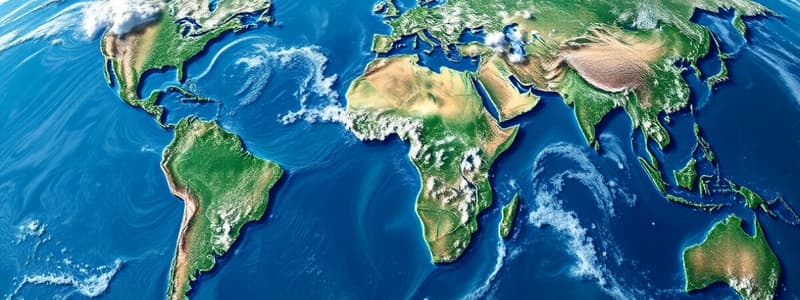Podcast
Questions and Answers
What is the main function of ocean currents?
What is the main function of ocean currents?
- They transfer heat from the equator to the poles. (correct)
- They filter pollutants from the ocean.
- They allow ships to navigate.
- They create tides.
Surface currents are influenced by prevailing winds and the Coriolis Effect.
Surface currents are influenced by prevailing winds and the Coriolis Effect.
True (A)
What are the two main types of ocean currents?
What are the two main types of ocean currents?
Surface and Density currents.
The __________ current flows north along the east coast of the United States.
The __________ current flows north along the east coast of the United States.
Match the currents with their characteristics:
Match the currents with their characteristics:
Which of the following is NOT one of the effects of ocean currents?
Which of the following is NOT one of the effects of ocean currents?
The surface currents have no impact on climate.
The surface currents have no impact on climate.
What role do winds play in the formation of ocean currents?
What role do winds play in the formation of ocean currents?
What is the primary feature of the California current?
What is the primary feature of the California current?
Density currents are caused by changes in temperature and salinity.
Density currents are caused by changes in temperature and salinity.
What is the process called that brings nutrient-rich water from the depths to the ocean surface?
What is the process called that brings nutrient-rich water from the depths to the ocean surface?
The Great Ocean Conveyor Belt is scientifically known as __________.
The Great Ocean Conveyor Belt is scientifically known as __________.
How long does it take for a complete cycle of the Thermohaline circulation model?
How long does it take for a complete cycle of the Thermohaline circulation model?
Match each surface current to its characteristic:
Match each surface current to its characteristic:
Surface currents bring cold, nutrient-rich water to the ocean surface.
Surface currents bring cold, nutrient-rich water to the ocean surface.
What is the role of smaller fish in relation to nutrients in upwelling areas?
What is the role of smaller fish in relation to nutrients in upwelling areas?
Flashcards are hidden until you start studying
Study Notes
Ocean Currents
- Ocean currents are "rivers" of water moving in a specific direction.
- Two main types of ocean currents: surface currents and density currents.
- Surface currents are influenced by global winds, the Coriolis Effect, and continent shapes.
- Density currents are caused by changes in density, influenced by temperature and salinity.
- Ocean currents are essential due to their ability to:
- Transfer heat from the equator towards the poles, allowing for a habitable Earth.
- Influence weather patterns and contribute to regional climates.
- Transport nutrients throughout the ocean, particularly important in cold environments.
- Cycle gases between the ocean and atmosphere.
Global Winds
- Prevailing (global) winds are Earth's major wind belts that influence the formation and direction of ocean currents.
- These winds only affect surface currents.
- Trade Winds:
- Flow towards the west.
- Located between 0° - 30° N/S.
- Westerlies:
- Flow from the west.
- Located between 30° - 60° N/S.
Surface Currents
- Surface currents transport warm or cold water horizontally across the ocean's surface.
- They play a significant role in shaping regional climates:
- Warm currents: associated with more humid climates.
- Cold currents: associated with drier climates.
- Examples:
- Gulf Stream: flows north along the East Coast of the US, leading to a humid climate in the Southeast US.
- California Current: flows south along the West Coast of the US, resulting in a dry climate with desert regions.
Density Currents
- Density currents occur far below the ocean's surface.
- Driven by differences in density (temperature and salinity).
- Upwelling: a type of density current that brings cold, nutrient-rich water from the depths to the ocean surface, often along coastlines.
Great Ocean Conveyor Belt
- A global "conveyor belt" formed by the combination of surface and density currents.
- Acts as a critical mechanism for transferring heat and nutrients throughout the Earth.
- Scientifically known as Thermohaline circulation:
- Thermo: temperature
- -haline: salt
- This circulation is driven by differences in temperature and salinity, creating a continuous flow of water.
- Estimated to take 1000 years for a complete cycle of the Thermohaline Circulation.
Surface Currents To Know
- North Atlantic Drift: a warm current extending off the North Atlantic.
- Gulf Stream: a warm current originating in the Gulf of Mexico, flowing along the East Coast of the US.
- Canary Current: a cold current flowing south along the western coast of Africa.
- Labrador Current: a cold current flowing south along the eastern coast of Canada.
- Benguela Current: a cold current flowing north along the western coast of South Africa.
- California Current: a cold current flowing south along the western coast of the US.
- Kuroshio Current: a warm current flowing off the East Coast of Asia.
- Peru Current: a cold current flowing north along the western coast of South America.
- East Australian Current: a warm current flowing south-east along the eastern coast of Australia.
- West Australian Current: a cold current flowing north along the western coast of Australia.
- Alaska Current: a warm current flowing southeast along the western coast of Alaska.
- Antarctic Circumpolar Current: a cold current flowing east around Antarctica.
- Norwegian Current: a warm current flowing north along the Norwegian coast.
- Brazil Current: a warm current flowing south along the eastern coast of Brazil.
- East Greenland Current: a cold current flowing south along the east coast of Greenland.
Studying That Suits You
Use AI to generate personalized quizzes and flashcards to suit your learning preferences.




